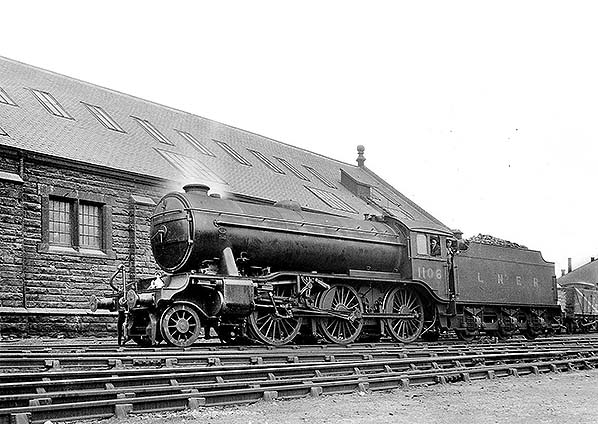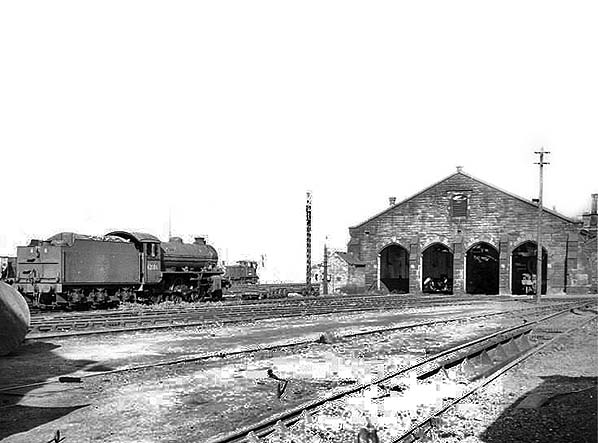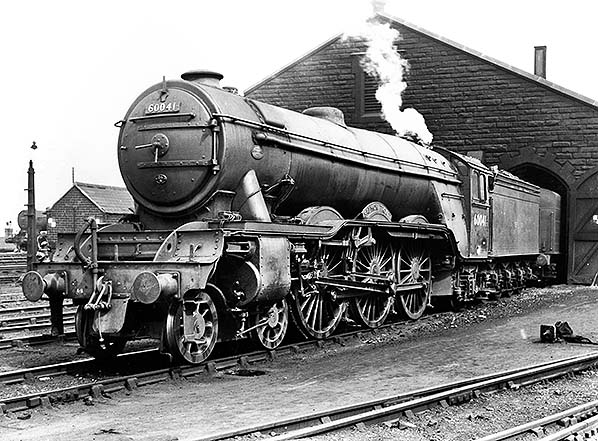
Station Name: TWEEDMOUTHold6.jpg) In 1935 Class C7 4-4-2 (Atlantic) No.2207 is seen at Tweedmouth with another member of the class. The loco was built in January 1917 at the NER works at Darlington. The LNER later renumbered her 2992, to which BR added a ‘6’ prefix, but it is unlikely that she ever wore this number as she was withdrawn on 1 November 1948 from 50E, Scarborough shed, to be cut up at Darlington Works, North Road, probably before the end of the year.
 The Gresley-designed K3 2-6-0, carrying its original LNER number 1106, is seen at Tweedmouth shed circa 1930s. The loco was built by Armstrong Whitworth in March 1931. No.1106 was renumbered 1902 by the LNER then received a ‘6’ prefix after nationalisation. She was withdrawn on 3 July 1961 from 53A, Hull Dairycotes shed and cut up at Doncaster works later that month.
old39.jpg)
The 1850 locomotive shed and coal drops at Tweedmouth, looking south-east in the mid 1930s'
Photo from Roger Griffiths collection old45.jpg) In 1953 Class J21 No.65082 is seen in the roundhouse shed at Tweedmouth. The Worsdell-designed 0-6-0 was built by the NER at the Gateshead works in May 1900 and allocated the number 807. She was renumbered 5082 by the LNER and then 65082 by BR. On 31 January 1955 she was withdrawn from 52D, Tweedmouth shed. Details of her disposal have not been found.
Photo from Railways of Berwick and the Eastern Borders private Facebook group old22.jpg) On 6 August 1957 the up ‘Heart of Midlothian’ express is seen at Tweedmouth, hauled by A3 Pacific No. 60035 ‘Windsor Lad’. The Gresley-designed 4-6-2 was built in July 1934 at the LNER Doncaster works, carrying the number 2500 and later 35. On 4 September 1961 she was withdrawn from 64B, Haymarket shed (Edinburgh,) and she was cut up at BR Doncaster works in September 1964.
Photo from Robin Barbour collection courtesy of Bruce McCartney  Photographed beside the original Tweedmouth loco shed circa 1960 is No.62006, a K1 class 2-6-0 built in June 1949 by the North British Locomotive Company, Glasgow. The loco was a Peppercorn development of a Gresley LNER design. She was withdrawn on 30 September 1966 from 54A, Sunderland South Dock shed, and cut up in January 1967 by Hughes Bolckows,
Battleship Wharf, North Blyth. Photo
from Railways of Berwick and the Eastern Borders private Facebook group
old23.jpg) On 6 June 1959 an 0-6-0T ‘Terrier’, built between 1874 and 1880 for the London, Brighton & South Coast Railway is in store at Tweedmouth roundhouse. This was one of three locos of the national collection housed there at the time of the photo. No.82 ‘Boxhill’ is preserved in the
National Railway Museum, York. Photo from Bruce McCartney collection old59.jpg) A scene in Tweedmouth roundhouse in June 1959. No.65706 is a Worsdell-designed J25 built for use on the North Eastern Railway at the company’s Darlington works. She carried the numbers 2055 and, later, 5706 in the LNER era. On 31 December 1959 she was withdrawn from 52F, North Blyth shed, and was cut up at BR Darlington Works, North Road in January 1960. No.31737 is far away from home. The D Class Wainwright-designed 4-4-0 was built at the South Eastern & Chatham works in Ashford, Kent. Numbered 737 in SE&C service she became 1737 under Southern Railway ownership. Withdrawn from 70C, Guildford shed on 30 November 1956 she was to be preserved and is now in the National Railway Museum Collection at York.
Photo from John Mann collection  Beside the 1850 locomotive shed at Tweedmouth in the undated photograph circa early 1960s is Gresley-designed A3 4-6-2 No.60041 ‘Salmon Trout’. The loco was built in December 1934 at the LNER Doncaster works and originally numbered 2506. Later the LNER changed the number to 41, and BR added the ‘600’ prefix. On 4 December 1965 she was withdrawn from 64A, St Margarets shed (Edinburgh) and the following September Arnott Young of Carmyle, Lanarkshire cut her up.
Photo by Brian Woods Snr. from Railways of Berwick and the Eastern Borders private Facebook group. old38.jpg) The frontage of Tweedmouth station is seen from the forecourt, looking east in April 1961. The building was designed by Benjamin Green, the architect of almost all of the Newcastle & Berwick Railway stations, which were to be built of sandstone ashlar. Whereas the other stations were more of a Tudor character, Tweedmouth was given a Jacobean treatment, with shaped (‘Dutch’) gables. A classical portico provided a dignified entrance for passengers – even though they had to share the forecourt with coal sidings and trucks.
Photo from Roger Griffiths collection old52.jpg) The NER roundhouse, looking north-west in 1968 across Billendean Road, some two years after Tweedmouth ceased to be a BR locomotive shed. While most of the structures at Tweedmouth station have been swept away, this building survives in 2015.
Photo by JC Dean 7.jpg) The grain terminal and a Polybulk wagon in Tweedmouth yard, seen in 1985.
Photo by Andrew Wylde from Railways of Berwick and the Eastern Borders private Facebook group 1.jpg) In August 1985 Class 03 shunter No.03063 is seen at Tweedmouth with a polybulk wagon. Photo by Andrew Wylde from Railways of Berwick and the Eastern Borders private Facebook group 2.jpg) Class 37 No.37279, based at Cardiff Canton would have been more at home shunting in the Valleys of south Wales, but here it is shunting in Tweedmouth yard in 1985.
Photo by Andrew Wylde from Railways of Berwick and the Eastern Borders private Facebook group 11.jpg)
A recent aerial view of the site of Tweedmouth station. South-west is at the top of the image. The East Coast main line and three engineers’ sidings cross the image diagonally. The ‘square roundhouse’ locomotive shed (NER 1877-78) top left, is one of only three structures associated with Tweedmouth station that survive in 2015. The two rows of houses (left) are another NER contribution, built in 1902 for railwaymen and their families. They are named Howick Terrace and Falloden Terrace after the two seats of the Grey family, whose influence on the building and management of the ECML in Northumberland stretched from its inception until the LNER era. Of red brick construction, the terraces were a standard design by William Bell, NER Chief Architect, and Fawcett (2005) remarks that they would have looked more at home on Tyneside; architecturally they were poor relations of the Newcastle & Berwick Railway’s terraced cottages for enginemen which, regrettably, have been demolished. The undeveloped area fanning out from the railway towards the lower right of the photo was the site of Tweedmouth station’s extensive goods facilities. The passenger station, of which nothing remains, was towards the right of the photo. Northumberland Road (A1167) passes underneath the railway the photo, far right. The third building associated with Tweedmouth station that still survives is the signal box (British Railways, 1961), beyond the right-hand edge of the photo.
Photo
by Neri Photography from their Flickr photostream
4.jpg)
In July 2015 ‘Sir Nigel Gresley’ is pulling out of Tweedmouth after a stop for water. The A4 4-6-2 loco was built in November 1937 at the LNER’s Doncaster works, at first carrying the number 4498 and later the number 7. BR renumbered her 60007. This class of locomotive performed with great accomplishment on the East Coast main line until displaced by the ‘Deltic’ diesel-electrics in the 1960s. This loco carried the name ‘Sir Nigel Gresley’ in honour of her designer. She was withdrawn on 1 February 1966 from 61B, Aberdeen Ferryhill shed, and has been preserved by the Sir Nigel Gresley Locomotive Trust.
Photo by Barrie Forrest from Railways of Berwick and the Eastern Borders private Facebook group 22.jpg) Tweedmouth, looking south-east from the site of the goods yard in July 2015. The site of the passenger station, long demolished, is behind the photographer. Three engineers’ sidings are in the foreground, with the main line beyond. The stone building in the distance is the NER roundhouse. Photo by Neri Photography from their Flickr photostream Click here to return to Tweedmouth first page
|

 Home Page
Home Page